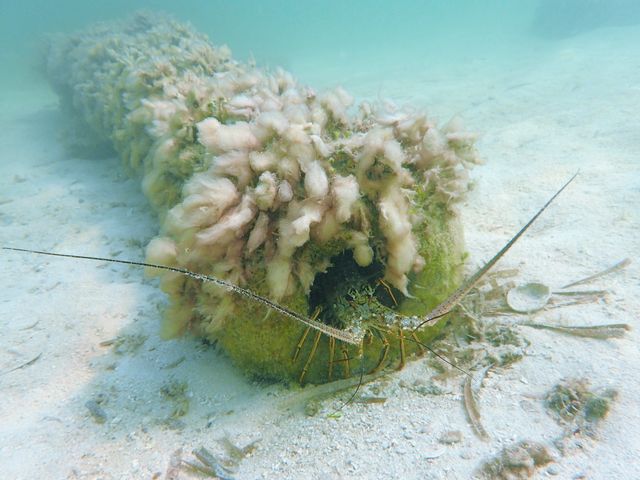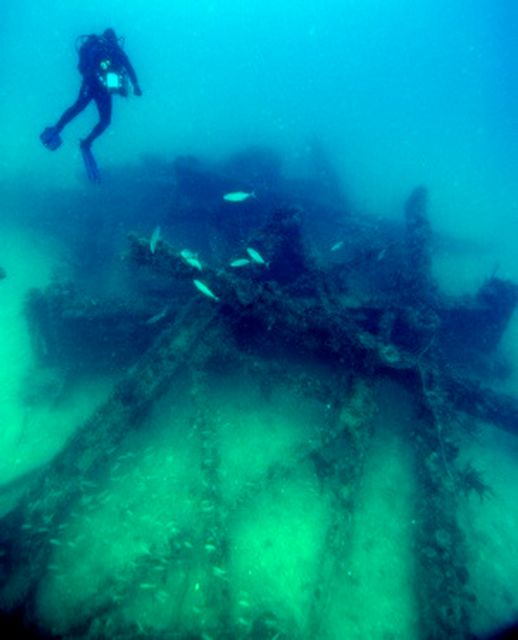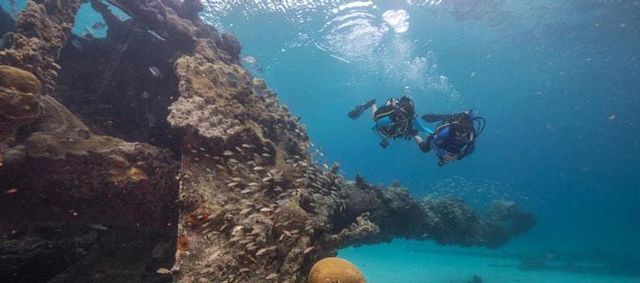Lesser-Known Florida Keys Wreck Dives
FLORIDA KEYS — Divers in the Florida Keys have many choices of fascinating shipwrecks to explore. Wreck dives include prominent sites like the Spiegel Grove off Key Largo and the Vandenberg off Key West — both massive vessels that were intentionally scuttled to become artificial reefs, and now attract divers and widespread attention.
Long before those vessels were sunk in Keys waters, countless ships met their demise due to hard-to-navigate shallow reefs and strong currents surrounding the subtropical island chain. Some of these lesser-known wrecks offer a unique look into Florida Keys history and an unforgettable experience for divers to add to their logbooks.
ISLAMORADA
The San Pedro, one of the Keys’ oldest shipwrecks, hosts a variety of sea creatures living amid ballast stones and coral heads. The 287-ton, Dutch-built ship sank in 18 feet of water just south of Indian Key near Islamorada during a 1733 hurricane. The ship was part of a Spanish treasure fleet attempting to sail from Cuba to Spain. Discovered in 1960, the San Pedro was heavily salvaged by treasure hunters, but its allure still draws divers and snorkelers to explore the site. Now protected as San Pedro Underwater Archaeological Preserve State Park, the wreck site is located one mile south of Indian Key. The colorful fish and soft corals that reside on the wreck make it popular with underwater photographers, snorkelers and novice divers.
The Cannabis Cruiser was a 70-foot trawler used to smuggle drugs into the U.S. in the 1970s. The craft was scuttled five miles off the coast of Islamorada and about three miles from Alligator Reef Light when those on board feared getting caught by an approaching Coast Guard ship. Many species of fish and sea creatures such as moray eels can be found on the wreck.
MARATHON
Henry Flagler’s Florida Keys Over-Sea Railroad, lauded on its completion as the most unique railway in the world, connected the Keys with mainland Florida and each other for the first time in 1912. Now portions of its structure lie submerged in 115 feet of water at a lesser-known site referred to locally as Marathon Reef or 7 Mile Bridge Reef, located approximately 3.2 nautical miles off Sombrero Beach.
Regarded as one of Marathon’s more challenging drift dives, the artificial reef site was created in July 1982. At that time, 4,500 tons of concrete and steel debris taken from the center swing span of the Old Seven Mile Bridge, also called the Moser Channel Bridge, were sunk.
Today those massive remnants provide refuge to abundant populations of large pelagic and reef fish, corals, colorful gorgonians, and plant and invertebrate marine life among the superstructure’s lateral bracing, fenders, gears and circular bearings that supported the bridge operator’s shed.
Divers can explore the concrete and steel rubble spread over 1.6 acres, rising off a flat sandy bottom as much as 30 feet in some areas.
KEY WEST
Seventy miles west of Key West in the waters of Dry Tortugas National Park lies the Windjammer shipwreck. Windjammer is the nickname of an iron-hulled ship-rigged sailing vessel whose last assigned name was Avanti. It sank during a winter storm in 1907 while transporting lumber from Pensacola, Florida, to Montevideo, Uruguay.
The Avanti remains in excellent condition because of iron's resistance to corrosion. There are two main wreckage fields, with the bow section oriented east-west and the stern section aligned north-south, resting at a depth of 22 feet at Loggerhead Reef about 1,000 yards southwest of the Tortugas’ Loggerhead Key.
Today the wreck offers divers and snorkelers a haunting glimpse of a once-proud sailing ship. The Avanti is the park’s most complete wreck site and provides a breathtaking backdrop for a wide variety of colorful reef fish, coral and marine life.
For more information about diving in the Florida Keys, visit fla-keys.com/diving/.
The Windjammer/Avanti wreck site in Dry Tortugas National Park provides a breathtaking backdrop for a wide variety of colorful reef fish, coral and marine life. Image courtesy of NPS.
The San Pedro site supports a variety of sea life, making it a favorite with divers and snorkelers. Image courtesy of Florida State Parks.
Steel debris was taken from the center swing span of the Old Seven Mile Bridge and placed on the sea floor as an artificial reef. Image courtesy of Keith Mille, FWC
The well-preserved Windjammer wreck on Loggerhead Reef in Dry Tortugas National Park is the most complete shipwreck in park waters. Image courtesy of NPS.




